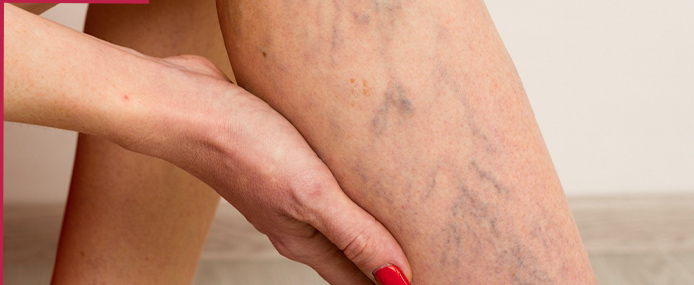Monday - Saturday
09:00 AM - 07: 00 PM

Prominently visible, large, purplish veins appearing through the skin are usually known as varicose veins. A milder version of this is known as spider veins. This condition more commonly affects women and is usually benign. The condition may, however, become painful at times. Veins that are affected with varicose are usually a cosmetic concern only, however, and appear to affect the legs due to the weight borne by them, more often. This condition is most often self-diagnosed and does not require laboratory imaging. In some cases, it may signify an underlying circulatory problem.
The primary symptoms of varicose veins are highly visible, misshapen veins, usually on your legs. You may also have pain, swelling, heaviness, and achiness over or around the enlarged veins. In some cases, you can develop swelling and discoloration. In severe cases, the veins can bleed significantly, and ulcers can form.
There are different types of varicose affecting superficial veins, and more rarely, more internal veins which can become swollen. Some of these types include:
There are some risk factors that may cause a higher probability of incorrect circulation. Causes of varicose veins include:
There are several possible complications that arise out of varicose veins, and although rare, they may sometimes trigger severe health consequences such as:
If family history ensures that varicose veins are to be inherited, there is little that may be done, but preventative measures may lessen their prominence, and keep the risks of developing varicose veins lower. Ensuring better circulation and building better muscle tone in the legs may help with the varicose veins, and also aids in mitigating the discomfort caused by existing ones. Some of the varicose veins prevention techniques include:
Varicose veins are usually self-diagnosed, and there is little in the way of diagnosis that may be attempted by experts since the condition is immediately apparent. Spider veins on feet may appear initially, with clusters of veins showing through and causing discolouration of the patches of skin they show through. A doctor will typically check for further inflammation and possible complications in the case of varicose veins to avoid ruptures and bleeding. They may also suggest an ultrasound test which is non-invasive or a venogram which requires the injection of a dye after which an X-ray is performed to understand if circulation is affected in the body, and in case the legs have blood clots.
Varicose vein treatment is usually suggested through lifestyle changes rather than through surgery. Lifestyle changes such as diet modification or exercise, as mentioned above, may help with curtailing the pain or prevention of further complications arising from varicose veins. Compression may be suggested in combination with other lifestyle changes, and specialized compression socks or tights will help the blood be pushed to the heart correctly despite damaged valves and help relieve some of the pressure on the veins in patients with varicose veins, thus reducing swelling. If the varicose veins are extremely painful and causing recurring discomfort to the patient, and none of the other methods provide relief, the doctor might suggest an invasive operation through which the varicose veins are removed. Vein ligation and stripping is a surgical treatment during which the surgeon surgically removes the varicose vein through incisions on the skin while the patient is anaesthetized. In some cases, slightly less invasive techniques may be utilized as well, which have become more commonly recommended in recent years.
Varicose veins are often considered ugly but rarely develop extreme complications. They tend to worsen with age, once developed, however, even if precautions are maintained. In case of surgery is not recommended by doctors, check-ups at frequencies suggested by doctors can help keep the possibilities of developing sores, ulcers or blood clots at bay. Being on the lookout for complications such as the development of a sore on or near a varicose vein, swelling of feet or ankles would help prevent worse developments. If such complications do not develop, varicose veins do not cause any medical problems.
Recovery after varicose vein surgery usually takes 1-5 weeks depending on the procedure, overall health of the patient, the size of the vein operated upon and care procedures followed. Some pain may be expected after the anaesthesia wears off, even in outpatient procedures. It is important to exercise and stretch after the procedure to ensure correct circulation. Also, watching out for any deteriorating symptoms after surgery is necessary, especially for the first few days, since areas operated upon are most prone to infection immediately after the procedure. Blood clots may also be seen in case of varicose vein surgery, and need to be considered seriously to avoid any circulatory issues.
In case lifestyle changes such as quitting tobacco or restriction of alcohol are suggested by the doctor, it is necessary to ensure that these aftercare measures are adhered to since some substances such as tobacco can delay healing. These may also affect the performance of pain medication, which, following varicose vein surgery, must be used in accordance with prescribed methods. Other lifestyle measures such as wearing compression socks or tights will help keep varicose veins under control and help quicker recovery from the surgery. Any measures to improve circulation to the legs, such as exercise regimens involving specialised yoga or stretching can help with aftercare following varicose vein surgery.
The goals of treatment are to relieve symptoms, improve appearance, and prevent complications such as serious skin ulcers or sores, deep vein thrombosis, skin color changes, and bleeding. Bleeding from varicose veins is a medical emergency.